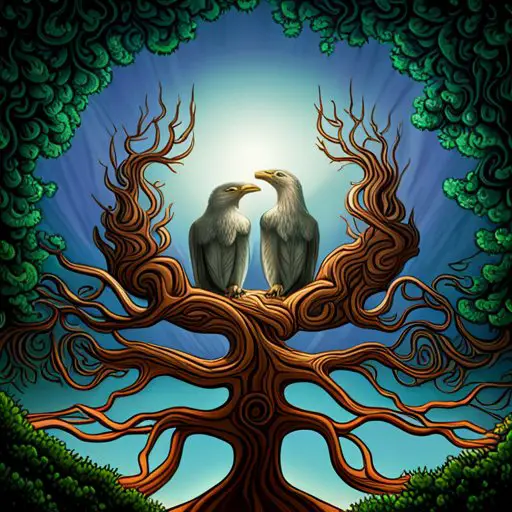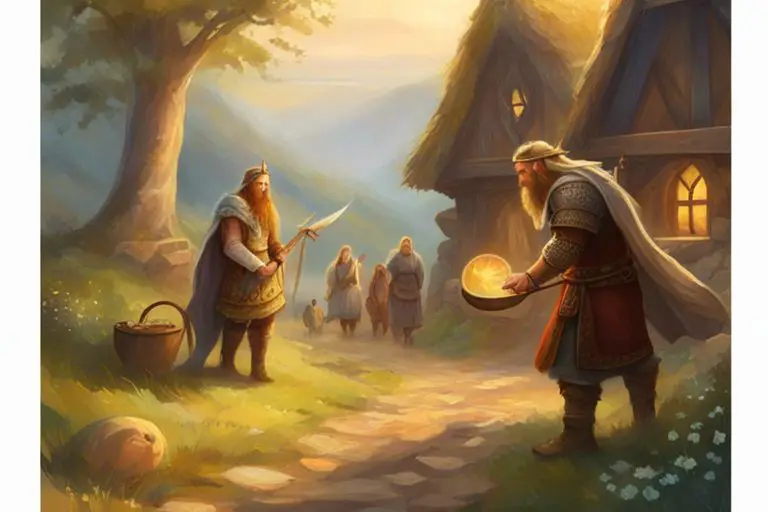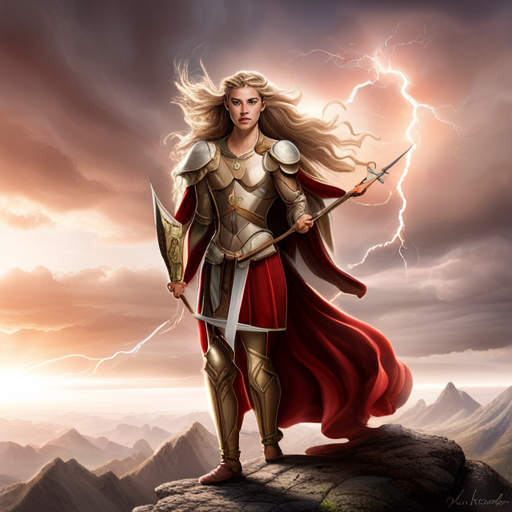As a lover of mythology, Norse mythology has always fascinated me with its intricate tales of gods, heroes, and mythical creatures. One of the most compelling aspects of this pantheon is the concept of Yggdrasil, the World Tree that connects the Nine Worlds of the Norse cosmos.
And at the top of this tree, perched on its highest branches, are two majestic eagles – Vedrfolnir and Hraesvelgr – guarding the world tree and all that lies beneath it. The symbolism and significance of these eagles in Norse mythology cannot be overstated. They represent power, strength, and watchfulness, and serve as protectors of the cosmos.
In this article, we will explore the origins and significance of Vedrfolnir and Hraesvelgr, as well as their role as guardians of Yggdrasil. We will also delve into the deeper meaning and symbolism of these eagles in Norse mythology, and how they fit into the larger cosmological framework of the Norse pantheon.
The Nine Worlds of Norse Cosmology
You’re about to learn about the incredible and vast realm of the Nine Worlds in Norse cosmology. These nine worlds are interconnected and exist within the branches and roots of Yggdrasil, the World Tree.
The first world is Asgard, home of the gods and goddesses. The second world is Vanaheim, home of the Vanir, a group of gods associated with fertility, wisdom, and the ability to see the future. The third world is Jotunheim, home of the giants and the enemy of the gods.
The fourth world is Midgard, the realm of humans. The fifth world is Alfheim, home of the light elves. The sixth world is Svartalfheim, home of the dark elves. The seventh world is Nidavellir, home of the dwarves.
The eighth world is Helheim, the underworld of the dead. And the ninth world is Muspelheim, home of the fire giants and the land of fire and heat. All of these worlds are connected and important in Norse mythology, and the World Tree Yggdrasil serves as a symbol of the interconnectedness of all things.
As we delve deeper into Norse mythology, we’ll explore the significance of vedrfolnir and hraesvelgr, two important figures in the mythology of the guardians of Yggdrasil.
Vedrfolnir and Hraesvelgr: Origins and Significance
Now, let me tell you about Vedrfolnir and Hraesvelgr, two creatures whose origins and significance play a vital role in the stories of the great eagles at the top of the world.
Vedrfolnir is a small, white rooster who resides atop the great world tree, Yggdrasil. His name means ‘weather-beaten’ and his task is to communicate the weather conditions of the other eight worlds to the eagle perched on the highest branch of the tree. Vedrfolnir is a messenger, a crucial link between the eagles and the rest of the world.
On the other hand, Hraesvelgr is a giant who takes the form of an eagle. His name means ‘corpse swallower’ and he is believed to reside at the end of the world, where he creates hurricanes by flapping his wings. Hraesvelgr is a force of nature, an uncontrollable power that can cause destruction in an instant. His role in the stories of the eagles is to remind us of the unpredictability of the natural world and the need for balance and harmony.
As we learn about Vedrfolnir and Hraesvelgr, we are reminded of the intricate web of relationships that exist in Norse mythology. The creatures in this world aren’t just characters in stories, but they’re part of a larger ecosystem that depends on each other for survival.
This realization evokes a sense of connectedness and belonging in us, as we’re reminded that we too are part of a larger whole.
The Role of the Eagles as Guardians of Yggdrasil
The role of the great eagles as protectors of the top of the world is crucial to maintaining order in the nine realms, as they’ve been known to ward off intruders with their powerful wings and sharp talons, according to ancient texts.
These guardians of Yggdrasil, the world tree, are believed to be the embodiment of the gods’ power and strength. Their presence at the summit of the tree serves as a reminder of the gods’ watchful eyes over the world and their willingness to protect it.
The eagles’ role as protectors isn’t limited to their physical prowess. They also serve as messengers between the gods and the people of the nine realms. It’s said that they carry the messages of the gods to those who seek their guidance.
As such, the eagles are not only guardians of the physical world but also of the spiritual realm. Their importance in Norse mythology can’t be overstated, and their symbolism and meaning will be explored in the subsequent section.
Symbolism and Meaning of the Eagles in Norse Mythology
As you delve into this section, you’ll discover the profound symbolism and meaning behind these majestic creatures, which transcend their physical form and embody the very essence of strength and power in Norse lore.
The eagles in Norse mythology are often seen as messengers of the gods, carrying important messages between the different realms of the cosmos. They are also closely associated with the god Odin, who’s often depicted with two ravens perched on his shoulder, representing his ability to see and hear everything that happens in the world.
In many ways, the eagles can be seen as an extension of Odin’s power, acting as his eyes and ears in the world of mortals and gods alike.
But the symbolism of the eagles goes beyond their association with Odin. In Norse mythology, the world tree Yggdrasil is seen as the center of the cosmos, connecting all of the different realms of existence.
The eagles, as guardians of Yggdrasil, are tasked with keeping watch over the tree and ensuring that it remains strong and healthy. This makes them not only symbols of strength and power, but also of balance and harmony in the world.
As we explore the larger cosmological framework of the Norse pantheon, we’ll see how the eagles fit into this greater picture of cosmic order and the balance of forces in the universe.

The Larger Cosmological Framework of the Norse Pantheon
Get ready to be transported into the vast and intricate cosmological framework of the Norse pantheon, where gods and goddesses, giants and dwarves, and even the elements themselves all play a vital role in shaping the fate of the universe.
At the center of this framework lies the world tree, Yggdrasil, which connects the nine worlds of Norse mythology. Each world is inhabited by different beings and creatures, and each has its own unique characteristics and qualities that are essential to the functioning of the universe as a whole.
The Norse pantheon is structured around a complex web of relationships and interactions between the various beings that inhabit the nine worlds. At the top of this hierarchy are the gods and goddesses, who are responsible for maintaining order and balance in the universe.
The giants and dwarves, on the other hand, are often portrayed as chaotic and disruptive forces that threaten the stability of the cosmos. Throughout Norse mythology, we see these different forces clashing and interacting with one another, each playing a crucial role in shaping the destiny of the universe and the beings that inhabit it.
Frequently Asked Questions
How did the Eagles become guardians of Yggdrasil?
As I learned about the history of the eagles guarding Yggdrasil, I couldn’t help but be struck by the powerful symbolism at play.
The eagles are known for their sharp vision and their ability to soar high above the earth, which makes them the perfect guardians for this ancient and sacred tree.
According to Norse mythology, the eagles were chosen by the gods to keep watch over Yggdrasil, ensuring that it remains strong and healthy for all eternity.
It’s easy to see why the eagles were chosen for this important role – their strength, intelligence, and grace make them a natural fit for such a vital task.
As I listened to the story of the eagles at Yggdrasil’s summit, I couldn’t help but feel a sense of awe and belonging, knowing that these powerful creatures are watching over the world tree and keeping it safe for generations to come.
What other creatures are associated with Yggdrasil?
When it comes to Norse mythology, Yggdrasil is one of the most significant symbols. It’s not only a tree, but it’s also a representation of the entire universe.
While the eagles are the most notable guardians of Yggdrasil, there are other creatures associated with it. The serpent Jörmungandr lies at the base of the tree, while a squirrel named Ratatoskr runs up and down its trunk, delivering messages between the eagle and the serpent. Additionally, there are four stags who nibble on the branches of the tree, representing the four cardinal directions.
Together, these creatures form a unique and complex ecosystem around the World Tree, embodying the interconnectedness and balance of the universe.
How does Yggdrasil connect the nine worlds of Norse cosmology?
Yggdrasil, the World Tree in Norse cosmology, serves as the axis mundi, the center of the universe that connects the nine worlds.
As I explore the mythology, I discover that the roots of Yggdrasil extend deep into the underworld, while its branches reach high into the heavens.
Its trunk stands in the center of the world, and it’s said that it is the dwelling place of many creatures, including dragons, serpents, and giants.
Yggdrasil not only serves as a physical connection between the worlds, but also a spiritual one, as it’s the site of many important events in Norse mythology, such as the binding of Loki and the prophesied battle of Ragnarok.
What other roles do the Eagles play in Norse mythology?
As I delved deeper into Norse mythology, I discovered that eagles play a significant role beyond guarding Yggdrasil’s summit. These majestic birds are often seen as messengers of the gods, carrying messages between the different realms.
They are also associated with Odin, the king of the gods, who’s said to have two loyal eagle companions. In addition, eagles are often depicted as fierce warriors, with their sharp talons and keen eyesight making them formidable opponents in battle.
Overall, the eagles in Norse mythology represent strength, wisdom, and connection between the different realms.
Are there any modern-day cultural references to the Eagles as guardians of Yggdrasil?
As I researched eagles in Norse mythology, I was curious to know if there are any modern-day cultural references to these birds as guardians of Yggdrasil.
I found out that some modern-day fantasy books and video games have incorporated the concept of eagles guarding the world tree in their storylines.
I also stumbled upon a few artworks depicting eagles perched on top of a massive tree, which reminded me of the Norse myth.
It’s fascinating to see how ancient mythologies continue to inspire modern-day art and literature, keeping these age-old tales alive for generations to come.
Conclusion
In Norse mythology, the eagles are more than just majestic birds of prey. They hold a crucial role in the protection of Yggdrasil, the world tree that connects the nine realms of Norse cosmology.
Through their vigilant watch, the eagles ensure the stability and order of the universe. But the symbolism of the eagles goes beyond their physical prowess. They represent the strength and wisdom needed to uphold the balance of the world.
They remind us of the importance of being vigilant and protective of the things we hold dear. As we look to the skies and see these magnificent creatures soaring above, let’s remember the guardians of Yggdrasil and the lessons they teach us.





